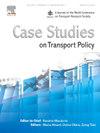Exploring factors influencing Commuters’ satisfaction towards regional transit System: A case of National Capital Region, India
IF 2.4
Q3 TRANSPORTATION
引用次数: 0
Abstract
Assessing the service quality of transit systems has gained massive importance in recent years. However, commuters’ satisfaction plays a significant role in determining the service quality of a transit system. This study attempts to examine the relationship of different attributes on the overall satisfaction of commuters using existing regional transit systems operated between Delhi, Gurugram, and Rewari districts of the National Capital Region (NCR), India. A questionnaire-based survey captured the satisfaction of 781 respondents over 27 attributes using a five-point Likert-type scale. The Structural Equation Modelling (SEM) is used to determine the relationship of the latent factors with the overall satisfaction of regional transit systems and is further used to identify the ones that are more important and have a strong effect on overall satisfaction using the importance performance map analysis (IPMA).
The result showcases that information at the station is the most satisfactory attribute, while commuters are least satisfied with the cleanliness of toilets at the station. Three latent factors are developed in the model, out of which, the latent factor Vehicle has a direct effect on the overall satisfaction at 0.01 significance level, while it is not the same in the case of the remaining two. The Vehicle latent factor is found to be a full mediator for the Station latent factor, while a partial mediator for the Service latent factor to influence the overall satisfaction of commuters using regional transit systems. Finally, the IPMA results indicate that the performance of overall satisfaction can be increased by prioritizing improvement in the performance of station related attributes, followed by those related to the vehicle. The relationship of different attributes and overall satisfaction derived in this study will assist the regional transit authorities in improving commuters’ overall satisfaction.
通勤者对区域交通系统满意度的影响因素探讨:以印度国家首都地区为例
近年来,评估交通系统的服务质量变得非常重要。然而,通勤者的满意度在决定交通系统的服务质量方面起着重要的作用。本研究试图考察不同属性对使用印度国家首都地区(NCR)德里、古鲁格拉姆和雷瓦里地区之间现有区域交通系统的通勤者总体满意度的关系。一项基于问卷的调查采用李克特五分制,对781名受访者的27个属性进行了满意度调查。结构方程模型(SEM)用于确定潜在因素与区域交通系统整体满意度的关系,并进一步使用重要性绩效图分析(IPMA)来识别更重要且对整体满意度有强烈影响的因素。结果显示,车站信息是乘客最满意的属性,而乘客对车站厕所的清洁度最不满意。模型中开发了三个潜在因素,其中潜在因素Vehicle对整体满意度有直接影响,在0.01显著水平上,而其余两个潜在因素对整体满意度的影响不相同。研究发现,车辆潜在因素对车站潜在因素具有完全中介作用,而对服务潜在因素具有部分中介作用。最后,IPMA结果表明,通过优先改善与车站相关的属性,其次是与车辆相关的属性,可以提高整体满意度的表现。本研究所得的不同属性与整体满意度的关系,将有助于区域交通主管部门提升通勤者的整体满意度。
本文章由计算机程序翻译,如有差异,请以英文原文为准。
求助全文
约1分钟内获得全文
求助全文

 求助内容:
求助内容: 应助结果提醒方式:
应助结果提醒方式:


